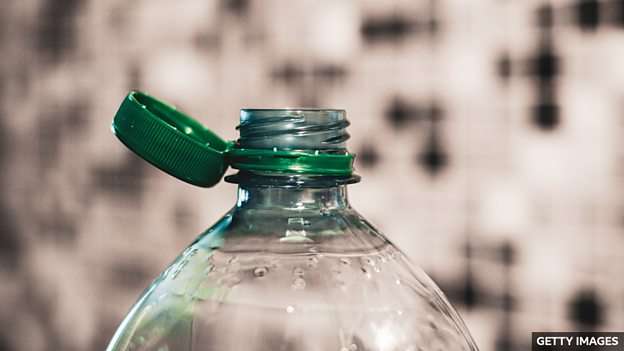在欧洲,一项新的规定要求饮料瓶的瓶盖需要和瓶子拴在一起,使其难以和瓶子分开。有不少人对这项规定感到不解,认为这让饮料瓶使用起来很不方便。但实际上,瓶盖已经成为了塑料垃圾污染的主要来源之一。本文讨论为什么摘不掉的瓶盖更有助于环保。
词汇:plastic waste 塑料垃圾
Squashed noses, scratched cheeks and t-shirts covered in sticky drinks. These are just some of the things that people are complaining about following the introduction of a new style of plastic bottle lid. Regulations in Europe now require manufacturers to tether lids to plastic drink bottles, making them difficult to remove.
Of course, the reason behind this measure is not to make people annoyed. It's because when lids get separated from their bottles, they become a big problem. As they're small, bottle caps are easily discarded, representing a high percentage of the plastic waste found on beaches. UK surveys reported that bottle tops were the third most common type of waste found as litter. They're more buoyant than bottles and so can travel further once they're in the sea. They are then often mistaken for food by sea birds or other wildlife, endangering their health. Wildlife photographer Chris Jordan, documented how Midway Atoll in the Pacific was covered with the bodies of thousands of seabirds whose stomachs were full of plastic pollution, much of it plastic bottle tops. It's not just discarded lids that can be an issue. Carefully disposed of lids can present a problem in recycling plants. They are often too small for the machinery used to sort rubbish and end up being sent to landfill.
Clever design could help reduce the scale of the problem. The way products are built can influence our behaviour. Consider a refrigerator that bleeps when left open too long. The alarm encourages us to close the door, saving energy. Renee Wever, writing in the International Journal of Sustainable Engineering highlights how metal drink can ring pulls were redesigned in the 1980s, to remain attached to the cans. This is the approach which has been taken with plastic bottles.
If bottle tops are attached to bottles, they are more likely to be disposed of properly and less likely to present a problem to wildlife. Many recycling plants find it easier to recycle caps when they are attached to bottles. Could it be that making something slightly more difficult to use could make a real difference to solving our plastic waste problem.
词汇表
regulation 法规
tether 拴住
cap 盖子
discard 丢弃
top 盖子
litter 被随意丢弃的垃圾
buoyant 能漂浮在水面上的
endanger 危害
plastic pollution 塑料污染物
disposed of 被丢弃的
recycling plant 垃圾回收工厂
sort 分拣
rubbish 垃圾
landfill 垃圾填埋场
energy 能源
ring pull (易拉罐的)拉环
can 易拉罐
attach 固定
测验与练习
1. 阅读课文并回答问题。
1. What complaints do people have about new-style tethered bottle lids?
2. Why are bottle lids easily discarded?
3. Why do lids travel further than bottles in the sea?
4. What problem can be caused by carefully disposed of bottle lids?
5. What design was changed in the 1980s?
2. 选择意思恰当的单词或词组来完成下列句子。
1. Many bottle caps are now _______ to the bottle.
discarded disposed tethered sorted
2. Waste has to be _______ before it can be recycled.
attached landfill sorted endangered
3. Plastic waste can _______ marine wildlife.
dispose of endanger attach litter
4. Plastic bottle _______ have become a major problem.
tether landfill tops energy
5. _______ can be dangerous if eaten by wildlife.
Discard Litter Ring pull Regulation
答案
1. 阅读课文并回答问题。
1. What complaints do people have about new-style tethered bottle lids?
People have complained about squashed noses, scratched cheeks, and t-shirts covered in sticky drinks.
2. Why are bottle lids easily discarded?
Bottle lids are easily discarded because they are small.
3. Why do lids travel further than bottles in the sea?
Lids travel further than bottles in the sea because they are more buoyant.
4. What problem can be caused by carefully disposed of bottle lids?
Carefully disposed of bottle lids are often too small for the machinery used to sort rubbish and end up being sent to landfill.
5. What design was changed in the 1980s?
Metal drink can ring pulls were redesigned in the 1980s.
2. 选择意思恰当的单词或词组来完成下列句子。
1. Many bottle caps are now tethered to the bottle.
2. Waste has to be sorted before it can be recycled.
3. Plastic waste can endanger marine wildlife.
4. Plastic bottle tops have become a major problem.
5. Litter can be dangerous if eaten by wildlife.

